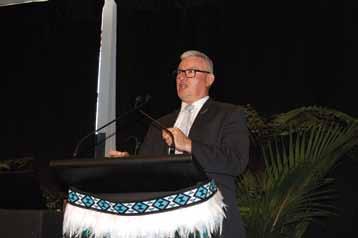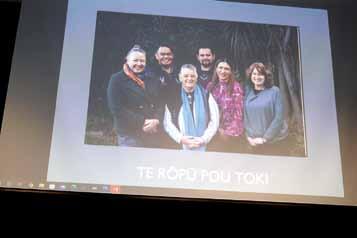
6 minute read
MāO r I ach IE v EMENT cOLL ab O raTI v ES (M ac ) Mak IN g a D IFFE r EN c E FO r Ta M ar I k I MāO r I
Liz hawes Editor
It is no secret that aotearoa New Zealand has a long history of racism and inequity. Like so many colonised countries, the real intention of colonisation was not so much to protect the rights of indigenous peoples, their language, culture and lands, but to assume power and sovereignty over them.
DESPITE ThE 1840 signing of Te Tiriti o Waitangi, which Māori believed gave them all the rights of Pākehā, without ceding sovereignty, the settlers didn’t interpret the agreement in the same way. They believed that the Treaty gave them full sovereignty and proceeded to colonise the country accordingly.
One way to ensure intergenerational power and sovereignty over indigenous peoples is through education.
It is indisputable that this was the case for Aotearoa New Zealand. The Native Schools Act 1867 established the first Native schools for Māori. The priority was to teach English with the intention of assimilating Māori into the Pākehā system. It wasn’t long before it was forbidden for Māori children to speak their first language at school. Alongside teaching only in English, came an expectation that the future role of Māori would be to work in servile labour rather than pursue academic aspirations.
With Māori children exposed to low educational expectations and having their identity, culture and language stripped from them, it is not surprising that over a hundred and eighty years later, Māori still sit at the bottom end of every educational, health, mental health and social statistic. As the years ticked by, teachers and principals became more aware that racism and denying tamariki their human rights to culture and language was contributing to the low educational expectations of schools and thus the lower achievement of tamariki Māori.
In 2011, Keri Milne-Ihimaera and Peter Witana, both principals of Far North schools, and members of the NZPF national executive, began a journey to develop a PLD option for principals which by 2012 would become the ‘Māori Achievement Collaborations’(MACs). A short time later Whetu Cormick was elected to the executive and joined Keri and Peter to push the MAC out the gate. The MAC was all about lifting the achievement of Māori tamariki through principals exploring their own identity, language and culture and through that process coming to appreciate that a Māori world view was just as valid and valuable as their own. With this knowledge and understanding, they would transform the culture of their own schools to allow tamariki Māori to feel included and know that their culture was valued alongside others.




Hoana Pearson, the first Te Pitau Mātauranga (programme coordinator), said at the outset, this is about changing hearts and minds. ‘Our actions are determined by our thinking which is determined by our perceptions, our beliefs, our assumptions, and our values. Even if they are based on myths and mistruths.’
She went on to quote Sergiovanni (1992) saying that, ‘Transformation requires new knowledge – to change our thinking and therefore our perceptions, beliefs, assumptions and values – from the head to the heart, to the hand.’

This is what we call transformational work. It is about conscientisation, or consciousness raising, a concept adopted from the work of Paulo Freire, a Brazilian educational theorist, – bringing racism and discrimination into consciousness and critically recognizing it for what it is. This is a confronting experience and requires skilled facilitation and the support of a caring, collaborative group. That is the work of the MACs.

By 2012, the first MACs were up and running. The Ministry of Education had agreed to fund the first tranche, providing the release time for principals to train as facilitators, to guide the principals in the MACs, who in turn had volunteered to undertake this journey of consciousness raising. The governance of the MACs represented a partnership between NZPF, Te Akatea (Māori Principals’ Association) and the Ministry of Education. As is often the case with a new venture, those early facilitators, led by Hoana Pearson, worked tirelessly to establish the kaupapa, whilst continuing to lead their own schools.

An accomplished scholar herself, Hoana was determined to secure a sustainable funding stream for the MACs and knew that to do so would require verifiable evidence of the success of the programme.
A group of education researchers from Auckland University came to her aid. Led by Dr Melinda Webber, they undertook an independent study of the schools from the first three MACs established. The results were glowing. The research study was able to link the changes in attitude of the principals through to changes in the culture of their schools which resulted in a substantial lift in the academic achievements of tamariki Māori.
More and more principals were observing how successful the MAC PLD was and they too wanted to join the ‘coalition of the willing’. Their numbers far exceeded the number of trained facilitators. The existing facilitators, not wanting to turn away eager principals, stretched themselves close to breaking point and Hoana, who was by now full time employed by the MAC
Board, took leadership of several MACs herself.
It was time for facilitators to be full time employed by the MAC, to do the important work only they could do, and it was time to relieve Hoana of all the administration work to be free to train new facilitators.
The Ministry recognized the power of the MAC to be transformational and established a funding stream so it could expand, and facilitators could be employed to work full time. With no advertising, principals flocked to the MAC which grew from serving 49 schools in 2013 to 428 in 2022. Principals continue to queue today.
October 31–2 November 2022 marked the first conference the Māori Achievement Collaboratives (MACs) had staged. There had always been an enthusiastically attended annual wānanga, usually hosted on a marae, but the numbers registered to attend in 2022 outstripped capacity for a marae-based event.


Hoana Pearson summed it up in her address to the conference saying, ‘The role of the education system and the educators within it is to maximise the cultural capital of the Māori learner as foundational to enhancing their mana, success and achievement culturally as well as academically.’

She quoted McKenzie & Singleton, 2009, p.5 saying, ‘The culture of the child cannot enter the classroom if it has not entered the consciousness of the teacher.’ Expanding on the quote she said, ‘It certainly won’t enter the school gate if it is not in the consciousness of the school principal . . . So, it requires deliberate and planned action . . . not just left to chance.’
Launch of Te whare Tapu O Te Ngākau Māori – Ki te whai ao, ki te ao Mārama
For true biculturalism to thrive in our schools, which is the aim of the MAC, the culture of schools needs to change. Culture change requires a new way of thinking and a new framework within which biculturalism can succeed.
It is from this thinking that Te Whare Tapu O Te Ngākau Māori was built. Authored, or architecturally designed by a group experienced in the MAC, including Hoana Pearson QSM (Ngāi Tūāhūriri, Ngāti Raukawa ki te Tonga, Ngāti Rangiwewehi), Leanne Otene, NZPF President for 2023 (Te Rarawa, Ngāti Wairupe rāua ko Ngāti Kuri), Damon Ritai (Te Ātiawa, Ngāti Mutunga, Taranaki, Ngāti Ruanui, Ngāruahine, Te Ātiawa ki Te Tauihu, Ngāti Rārua, Ngāti Koata), Te Ringakaha Tia-Ward (Ngāti Toki, Ngā Puhi) and Hayley Read (Ngāti Pākehā), the book is a framework to support the growth of a new education system to support all learners (akonga).
It adopts the structures of marae which mirror the way knowledge of Te Ao Māori, Te Reo Māori me ona tikanga, develops over time. The book is not only a narrative of this process towards biculturalism, it comes with a kitset marae. This allows akonga to engage in the physical process of building a model marae to better understand all the different concepts and how they fit together. Akonga can immediately see the interdependencies of the different pieces of the structure if the marae is to hold up. Any missing or misplaced pieces and the marae will not stand. Each essential piece of the model is labelled and described in the book. It is an ingenious approach and immediately appealing. To use the book to advantage requires PLD for principals and staff, and this is offered by the MAC facilitators.
Te Whare Tapu O Te Ngākau Māori was launched at the MAC conference. Delegates enjoyed a firsthand demonstration of the marae model building project, while Hoana Pearson provided a commentary. She described how the framework has been built and how Te Ao Māori can be developed in schools as an equal and valued world view in which all akonga can immerse themselves and be successful learners.








